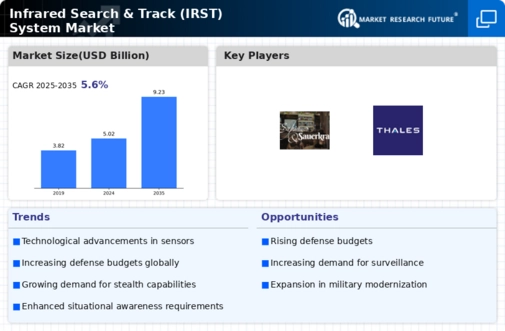Market Share
Infrared Search Track System Market Share Analysis
The Infrared Search and Track System (IRST) market is undergoing transformational changes due to developments in sensor technologies and the increasing significance of passive detection capabilities in contemporary warfare. A notable trend is the greater integration of multi-sensor IRST systems. IRST manufacturers are producing systems that combine infrared sensors with radar and electro-optical sensors among others, thus providing comprehensive situational awareness. The integration makes it possible for a system to detect and track more than one target at the same time through which military forces can become more comprehensive and layered in their approach to threat detection.
In addition, there has been a trend towards miniaturization as well as weight reduction of IRST systems. As technology progresses, businesses are striving to come up with small-sized and lightweight IRST systems capable of being fitted on various platforms including but not limited to airplanes, naval vessels, or ground-based vehicles. This caters for an increasing demand for flexible portable IRST solutions across different operational environments.
Furthermore, there is a shift towards passive IRST systems that have longer range detections. Manufacturers are investing in research and development (R&D) efforts aimed at increasing the range and sensitivity of infrared sensors so that they can enable an ISRT system to spot hazards from further away. This reflects how modern warfare is changing where early identification of potential dangers plays a major role in maintaining strategic advantages on the ground
The use of artificial intelligence (AI) also known as machine learning algorithms has become another growing trend in the market for IRST Systems; this empowers them to be utilized properly by human beings who can employ these tools for real-time intelligence processing thereby improving the reliability within any given mission execution time frame. Therefore, manufacturers have incorporated advanced algorithms into their products such that any information collected through such sensors goes through stepwise analytics which helps in terms of making quick decisions regarding threats identification with higher accuracies through faster processes than before. Thus this permits them to perform more efficiently in complex and dynamic theatres of operations.
Moreover, there is an increasing focus on the development of IRST systems with multi-angle and 360-degree coverage. Manufacturers are creating systems that provide complete coverage around the platform which eliminate any blind spots hence improving overall situational awareness. This goes hand in hand with a need for continual and seamless threat monitoring especially in hostile environments where threats may come from different directions.
Additionally, the market is witnessing growing use of IRST systems by naval applications. Naval ships are increasingly relying on such systems to improve anti-ship missile defense capabilities. By detecting and tracking low observable threats like sea-skimming missiles, IRST systems can add another layer of security to naval platforms. The maritime sector has therefore recognized the importance of this technology in dealing with emerging threats at sea.
Furthermore, there is a move towards integrating IRST systems into Unmanned Aerial Vehicles (UAVs). The integration of ISRT system is significant because UAVs are now being used more extensively for both military as well as surveillance purposes so they can take part in detection missions easily owing to their modified ISRT equipment. This goes with modern war strategies whereby unmanned platforms should have advanced sensor capability.





Leave a Comment